Low-impact clothes - introduction
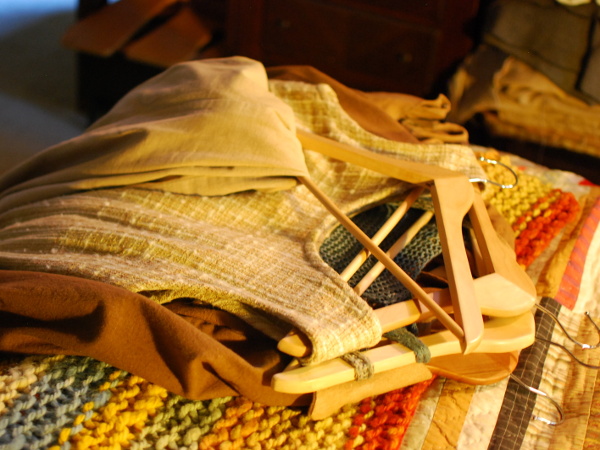
“Fast fashion, whilst having increased the accessibility of stylish clothes for millions, has unfortunately resulted in many horrific practices, such as child labour, that exploit millions of people around the world in poorer, developing countries. This something that has to change, and we can all start by reflecting on where our clothes come from.” – Philomena Kwao
Contents
What are low-impact clothes?
It’s difficult to define low-impact clothes in the same way as topics such as knitting, sewing or weaving, as there are so many aspects to consider. For convenience, we can categorise them in two ways:
- Sustainable – i.e. made from materials that are as natural (or recycled); durable (and mendable); produced without pesticides or other toxins; made locally, and with locally-produced materials (to reduce the distance that both the clothes and materials have to be transported); dyed with non-toxic, natural dyes.
- Non-corporate – i.e. home-made, second-hand, or produced by small businesses, sole traders or co-ops.
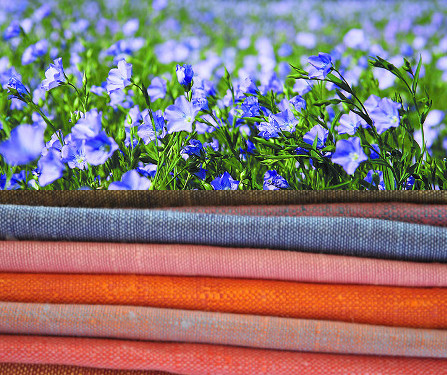
Historically, people tended to have a loom in their home, and further back still, clothes were made from whatever came from the immediate environment – mainly fur and skins. At about the same time as the agricultural revolution, weaving was born. The heddle – the device that splits threads to make cloth – is one of most significant inventions in human history.
Weaving, by the way, has also had a big influence on recent history. It’s structured around a grid, and if you want a pattern, you have to programme the loom to make it. This can be done manually, but a Jaquard loom involved punched cards to work out the order of threads, which led to the development of computers.
Clothing is not only something that protects us and keeps us warm, it’s also important culturally. There’s a long tradition of oral history around textiles. For example, ‘close knit’ means that cloth has a balanced structure that holds together well, which is why the term is used for a well-functioning community.
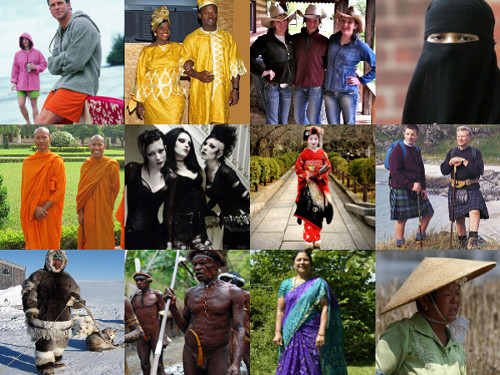
Trade in textiles goes back a long way. In Europe, and in the UK particularly, there was an important wool industry, traded for silks coming from the East, along the Silk Road. Cloth was always valuable and precious, because of the skill and time required to make it. After the Industrial Revolution machines made things much easier, and since then more short cuts have been found using cheap labour and synthetic materials and dyes.
Low-impact clothes are all about reinstating the value of textile and clothing manufacture. We don’t all have to go back to having a loom in our homes (unless you want to of course, in which case we encourage it). But there will be people in your community who enjoy making fabrics and clothes, and so we can give them our custom. Clothing was always a community activity. It wasn’t usually possible to do everything yourself – it involved sheep farmers, growers, shearers, leatherworkers, felters, sewers, knitters, weavers, spinners and dyers.
Low-impact clothes will require a sea-change in the clothing industry, which bows to the demands of fast fashion. Because of advertising, the public tend to want new clothes all the time, and actually they need them, because of their poor quality. But now there is more of a premium on branding than on durability or sustainability.
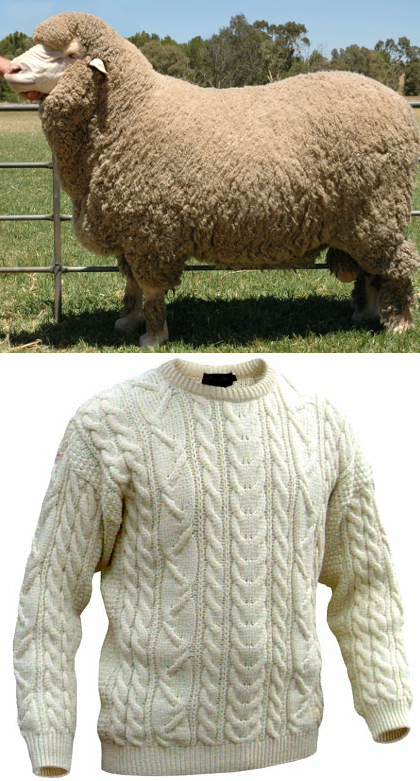
What are the benefits of low-impact clothes?
The benefits of low-impact clothes are best illustrated by highlighting the problems of the current high-impact clothes industry.
Materials
The introduction of petroleum-based, synthetic textiles made care of clothes much easier, but your skin breathes through your clothes, and as synthetics are non-breathable, they make you and your clothes smell, which means they have to be washed more often, which requires more energy, water and detergent. On the other hand, recycled plastics can be made into fibres to make clothes. This isn’t a good basis for a clothes industry though – the manufacture of plastics involves a lot of pollution, which causes environmental damage and health problems for people who work in the industry. It’s also impossible to dye synthetic clothes with natural dyes, and there are lots of synthetic textiles rotting in places we can’t see them, slowly emitting toxins.
So, natural materials – but which ones? Cotton is the obvious choice, and you can now get organic and Fair Trade cotton. But cotton doesn’t grow in the more temperate climates where the big markets are, and it’s a crop that requires a lot of water and usually a lot of pesticides, plus it tends to be grown in huge monocultures.
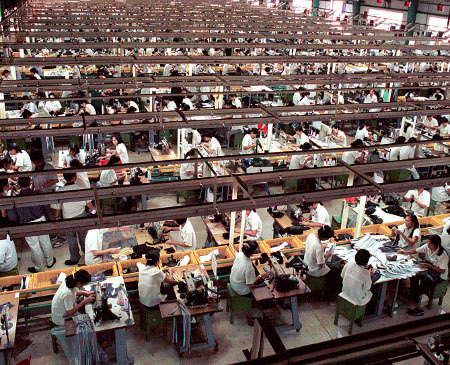
Linen (from the flax plant) grows in colder climates. It creases more easily and requires more care than cotton, but the real reason that cotton is so popular is because it’s the only fibre that is traded on stock markets, and so the global clothing industry has developed in a way that favours cotton. Flax is the oldest textile fibre in the world, is extremely durable and has a unique cooling effect. It offers protection from sun, but is very breathable. Linen for summer, wool for winter. Flax doesn’t need pesticides or much irrigation.
The hemp plant has always been considered a weed, but is easy to grow in most climates, doesn’t need very much irrigation or pesticides and produces strong fibres and good clothing, not just rough fabrics like burlap sack etc.
Wool will cope with hot, cold, wet or dry conditions. It will adjust because it comes from an animal. Wearing a polyester t-shirt is like wrapping yourself in cling film, in that it inhibits natural bodily functions and prevents the pores of the skin from breathing. Wool and natural fibres allow your skin to breathe
Other (less sustainable) textile materials include modal – a type of rayon made from cellulose extracted from beech wood shavings, dissolved in a natural acid; and you can now buy bamboo clothes, made with a method of removing cellulose that is not altogether environmentally-friendly.
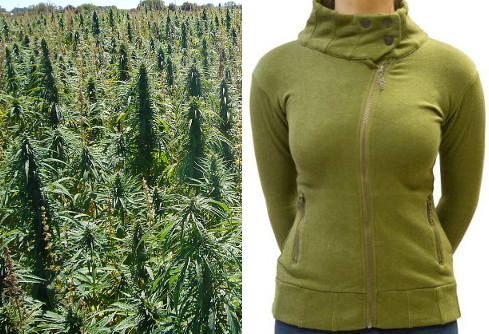
Provenance
The scale of manufacturing is important. If clothes are made on a huge scale, short cuts are taken to maximise returns to shareholders, resulting in not only shoddy goods, but also huge, exploitative sweatshops that are famous for paying workers a tiny fraction of the retail price of the clothes they produce; plus with large-scale manufacturing, pollutants are concentrated, causing problems that nature could cope with and neutralise much more easily in a more dispersed industry of small-scale producers (and especially if they were producing naturally and for a local market).
But it’s almost impossible to trace the provenance of corporate-branded clothes, as there is so much sub-contracting. However, if each country managed to manufacture all or most of its own clothing, from home-produced materials, the clothes trade in poor countries need not suffer, as their domestic markets are growing rapidly, and rightly so. Western markets are becoming less important. If they can organise production in a less corporate way, the lives of textile workers could become much healthier and more satisfying relatively quickly. Perhaps then they could remove the nets around corporate factories that are there to prevent workers from committing suicide.
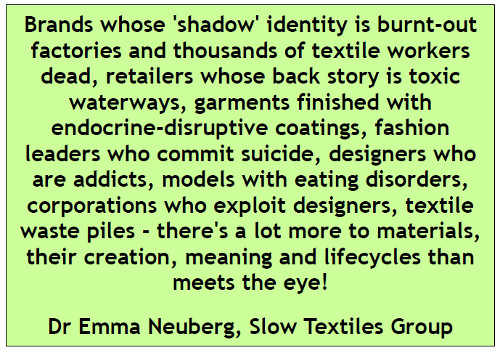
What can I do?
Buying clothes
Possibly the most important thing when buying low-impact clothes clothes is to ignore the fashion industry. That doesn’t mean not being creative – it just means not allowing other people to tell you how to dress. It also means avoiding corporate brands, who often try to turn you into walking advertisements for them, especially when it comes to sportswear. The raison d’être of the corporate fashion industry is to build obsolescence into our clothes, and to persuade us to buy more than we need. Over 50% of clothing sold in the UK eventually ends up in landfill. Even in charity shops a huge amount of clothing remains unsold and is baled up and sent to Africa. Although intended to be helpful, this actually destroys the local clothing industry, because you can’t compete with goods that are free.
You can find non-corporate clothing outlets locally, as well as second-hand sources, of course.
Also, buy good-quality clothing that lasts, and if you can, buy clothes made from natural materials that haven’t travelled very far. Countries like the UK no longer have a clothing industry big enough to clothe everyone using UK-produced materials, although there are lots of great organisations and individuals working on that (see video below). Looking at what your country can produce can reconnect people with the land in terms of textiles as well as food, generate greater respect for clothing and reduce waste.
Although a lot of sheep are raised in the UK, most wool is thrown away, as it’s too expensive to wash, card, spin, knit, weave or dye it, relative to the price of the finished product. Low-impact clothing will be more expensive than synthetic clothes made in sweatshops, for obvious reasons, but it could save you money in the long run, because you won’t be throwing out clothes that are no longer trendy, and the quality will mean that they last longer; and a more general point is that money will stay in local economies, rather than being extracted to pay corporate shareholders, which will benefit all of us ordinary mortals.
Washing machines make life easier, but we tend to wash clothes after wearing them once, because they’re not breathable. Pure wool, for example, contains natural oils that mean it doesn’t need washing very often. You can’t wash wool in a washing machine anyway, but usually it just needs airing, which saves energy and money. It would be very good to reinvigorate the UK wool industry. Sheep have to be shorn once a year – we’ve bred sheep for the wool industry and it grows profusely.
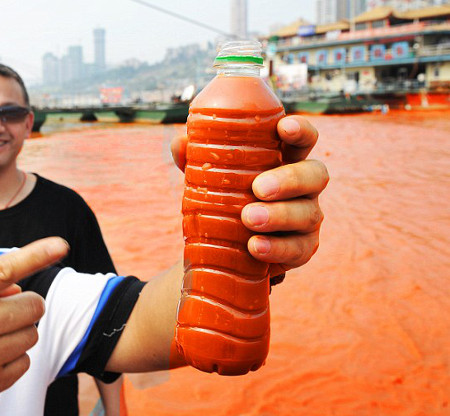
Making clothes
If you’re going to make your own low-impact clothes, you’re going to need one or more of these skills:
Or to go a bit further back in the process:
Or futher back still:
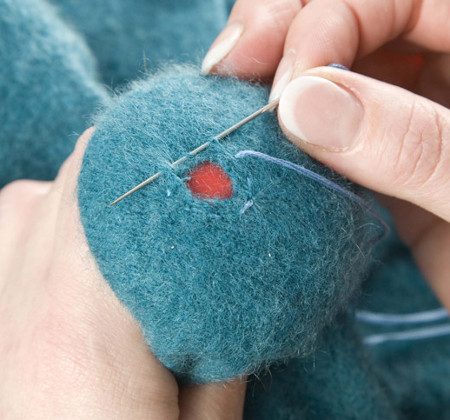
And of course it’s good to repair things – darning socks and patching clothes are becoming more common. Ultimately, if low-impact clothes made from natural materials can’t be repaired any more, they can be composted or used for insulation.
Specialist(s)
Thanks to Jess Smulders-Cohen of Greater London Fibreshed for information.
The specialist(s) below will respond to queries on this topic. Please comment in the box at the bottom of the page.
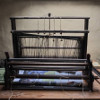
The Green Cloth Collective is a network of textile and other makers concerned with a deep green economics for the common good. We believe that an empowered populace is one that knows how to make, and make a living. We weave our own close-knit but open, online community for maker support, trade and exchange. Eloïse Sentito of These Isles will field your comments for Green Cloth members’ responses.

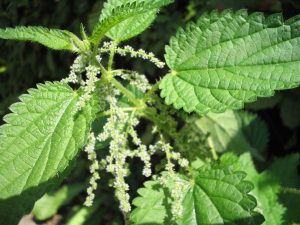
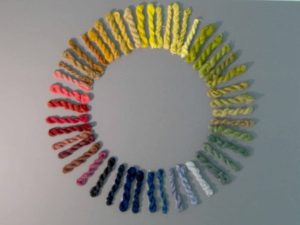
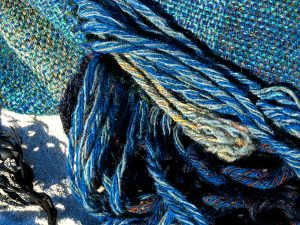
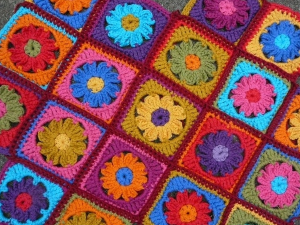
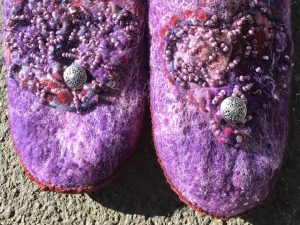

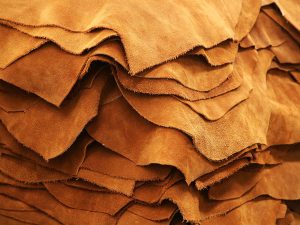
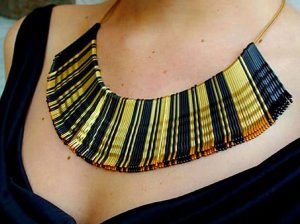

1 Comment
Although a lot of sheep are raised in the UK, most wool is thrown away, as it’s too expensive to wash, card, spin, knit, weave or dye it,
relative to the price of the finished product.
Low-impact clothing will be more expensive than synthetic clothes made in sweatshops,
for obvious reasons, but it could save you money in the long run, because you won’t be throwing out clothes that are no longer trendy,
and the quality will mean that they last longer; and a more general point is that money will stay in local economies,
rather than being extracted to pay corporate shareholders, which will benefit all of us ordinary mortals.
Washing machines make life easier,
but we tend to wash clothes after wearing them once,
because they’re not breathable. Pure wool, for example,
contains natural oils that mean it doesn’t need washing very often.
You can’t wash wool in a washing machine anyway,
but usually it just needs airing, which saves energy and money.
It would be very good to reinvigorate the UK wool industry.
Sheep have to be shorn once a year – we’ve bred sheep for the wool industry and it grows profusely.